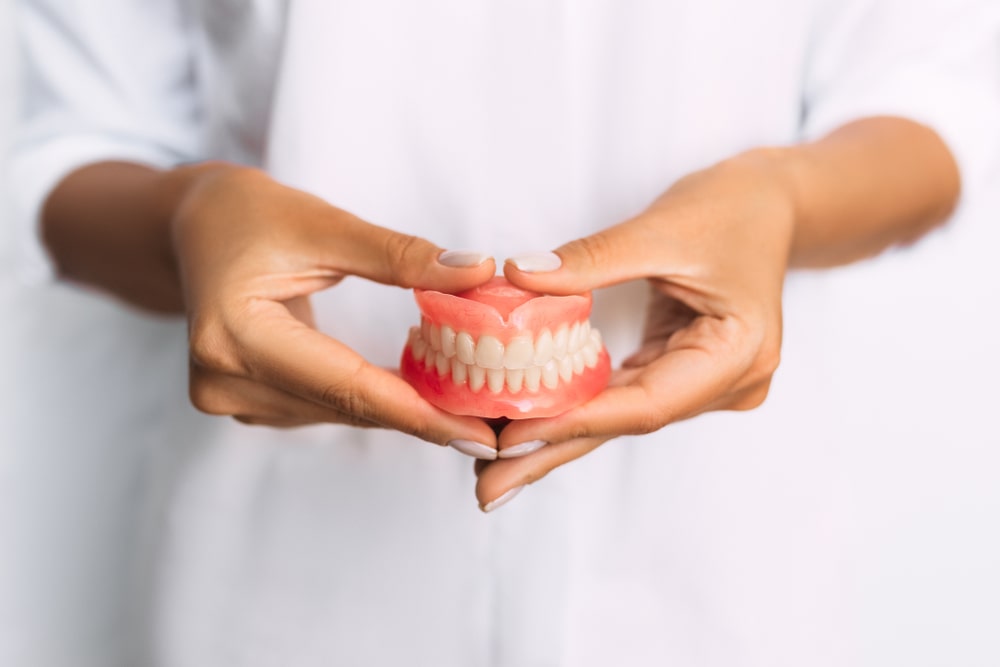Dentures and partial dentures are removable prosthetic devices that can replace a single tooth, numerous teeth, or all of the teeth in your mouth. A denture or partial denture is generally a more economical solution for missing teeth than implants, crowns and bridges. A full or complete denture refers to a denture that is designed to replace all the top teeth, or all of the bottom teeth in a patient who no longer has teeth. Traditionally, complete dentures relied on natural suction or the use of denture adhesive pastes to keep them secure while eating or speaking. Nowadays this design can often be supplemented with a couple of strategically-placed implants to provide superior retention. A partial denture is a removable appliance that is worn by someone missing one or many teeth, but who still has some healthy, sturdy teeth in their mouth. A partial denture fills in the spaces with artificial denture teeth, and has clasps that secure the partial denture to the strong teeth for support and stability while speaking or chewing. Both full dentures and partial dentures are intended for wear during the day, but should be removed at night for cleaning and to allow the natural tissues of the mouth to refresh.
Is a denture right for me?
A denture relies on a combination of sufficient bone structure under the gums, and a well-shaped upper palate and lower “ridge”. If you have been a denture wearer for many years without problems and you are ready to replace an older, worn denture, then you are an ideal candidate for a new denture. If you have worn an upper partial denture but now need to have your remaining upper teeth extracted, you will likely have an easy time adapting to the new upper full denture. However, it is usually not as simple when it comes to full lower dentures. If you have worn a lower partial denture in the past but now need to have your remaining lower teeth extracted, it may be difficult to adapt to the loss of stable supporting teeth to keep the new full denture in place. There is a simple reason for this difference: Without teeth, most people’s “upper mouth” has a well-shaped palate with lots of surface area for a denture to cover. The high arch of the palate also allows an upper denture to form suction with the roof of the mouth to provide for a strong, natural bond. However, without any lower teeth, the lower ridge is only a narrow “horseshoe-shaped” structure, and in place of a palate there is a tongue, which is a large, strong muscle that moves all around during speaking and eating. The tongue, especially when combined with a lower ridge that is often flattened and small, creates an environment that works against keeping a full lower denture securely in place. Denture adhesive pastes can help, but strategically-placed implants in the lower ridge upon which the lower denture can snap into place can completely eliminate the instability inherent in lower dentures.
Is a partial denture right for me?
For most patients who may be missing some upper and/or lower teeth but have other healthy, strong teeth in their mouths, a partial denture can fill in spaces, contribute to improved chewing, and improve appearance. Unlike with implants or bridges, there is no need for anesthesia, surgery, drilling of teeth, or long appointments. Partial dentures can be made from flexible plastic frameworks, or cast-metal substructures, and the choice of materials often depends upon the number of missing teeth and the specific design of the appliance. Many patients wear partial dentures for decades, while other patients wear them for a short period of time, until they can take on more extensive permanent tooth replacement.
Sequence of events in denture and partial denture fabrication:
First, detailed impressions of your mouth will be taken and sent to our denture laboratory. Your dentist will make notes about the type of denture teeth that will best suit your individual needs, and will consult with you on tooth color.
At the second visit, the lab will have designed a temporary denture base (for a full denture), or a framework (for a partial denture). Your dentist will try this in and make specific measurements in wax that will help the lab to know things such as: how your upper and lower teeth come together when you bite, how much your front teeth will show when you are smiling and speaking, and how much volume is needed to keep your lips and cheeks from looking “sunken-in” or hollow. This work is then returned to the lab.
The third visit will be for a try-in. The lab will have placed the new denture teeth into the full or partial denture, but the artificial “gums” will still be made of wax. This gives both you and your dentist the opportunity to see exactly how the dentures will look in your mouth, and allows for corrections to be made before final processing. At this visit, if it is agreed that the try-in is perfect, it is sent back to the laboratory for final processing. If corrections are required there may be additional try-in appointments until the denture looks just right.
At the final visit, your dentist will insert the denture and make any necessary adjustments. Getting used to a new full or partial denture takes about two weeks for most patients, and many will need to return for some minor adjustments during this time.

